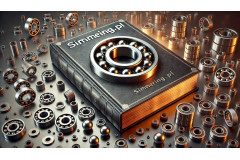
Technical Seals – A Comprehensive Guide to Simerings, O-rings, and O-ring Cords
Technical seals are a crucial element in many industrial, automotive, and mechanical applications, ensuring reliable operation and protection against leaks or contamination. In this article, we will take a closer look at three popular types of seals: simerings, O-rings, and O-ring cords. You will learn about their characteristics, applications, and key technical features.
Simerings – Reliable Shaft Seals
What Are Simerings?
Simerings, also known as rotary shaft seals, are flexible technical seals that play a crucial role in protecting rotating shafts from contamination, moisture, and oil or grease leaks. Their function is to maintain the seal between moving and stationary components in machines and devices, such as engines, gearboxes, and pumps.
Construction and Materials of Simerings
Simerings consist of several essential components:
- Sealing ring: Usually made of rubber (NBR, FKM, MVQ) or another elastomer that provides flexibility and sealing capability.
- Lip spring: Responsible for pressing the sealing ring against the shaft, enabling an effective seal.
- Metal housing: Adds rigidity to the simering and facilitates its installation.
Simerings made from elastomers with different resistance properties can be customized to operate in demanding conditions, such as high temperatures, exposure to chemicals, or high rotational speeds.
Applications of Simerings
Simerings are widely used in industrial and automotive sectors. Some common applications include:
- Engines and gearboxes: They prevent oil leaks, protecting mechanical components from damage.
- Agricultural and construction machinery: They shield against dust and dirt in challenging working environments.
- Pumps and compressors: They seal rotating shafts in industrial applications, ensuring smooth, uninterrupted operation.
Types of Simerings
There are various types of simerings available on the market, such as:
- TC Simerings: Double lip seals, ideal for applications with heavy loads.
- SC Simerings: Single lip seals, used in simpler applications.
- Simerings with dust lips: Provide protection from external contaminants.
O-rings – Versatile Circular Seals
What Are O-rings?
O-rings are one of the most widely used technical seals, known for their versatility and simple design. They have a circular shape and are primarily used for static and dynamic sealing between mechanical components. Made from various elastomers, they can be tailored to suit different industrial applications.
O-ring Materials
O-rings can be made from a variety of materials depending on the application requirements. The most common materials include:
- NBR (Nitrile Butadiene Rubber): Commonly used due to its excellent resistance to oils and fuels.
- FKM (Viton): Offers superior resistance to high temperatures and aggressive chemicals.
- EPDM: Resistant to water, steam, and UV exposure, making it ideal for outdoor applications.
- Silicone (MVQ): Used in applications requiring high flexibility across a wide temperature range.
O-ring Applications
O-rings are used in many different industrial sectors:
- Hydraulic and pneumatic industries: Used as seals for cylinders and valves.
- Automotive industry: Seals for engines, gearboxes, and cooling systems.
- Chemical and food industries: Due to their resistance to chemicals and high temperatures.
Types of O-rings
O-rings vary not only in material but also in shape and purpose:
- Standard O-rings: The most common type, available in many sizes and thicknesses.
- O-rings with sealing lips: Used in dynamic applications, providing better sealing for moving parts.
- Metal-reinforced O-rings: Used in harsh environments where a combination of rubber flexibility and metal strength is required.
O-ring Cords – Flexibility and Customization
What Are O-ring Cords?
O-ring cords are flexible seals in the form of continuous lengths of material that can be cut and shaped into rings of any size. They are an ideal solution when standard O-rings with fixed dimensions do not meet the application's requirements.
Applications of O-ring Cords
O-ring cords are widely used in applications such as:
- Machinery and equipment manufacturing: For sealing non-standard connections in specialized equipment.
- Food and pharmaceutical industries: Due to their ease of customization for non-standard seal dimensions.
- Chemical industry: Resistant to aggressive chemical environments.
O-ring Cord Materials
Like standard O-rings, O-ring cords are made from various elastomers:
- NBR: The most popular material for O-ring cords due to its low cost and good resistance to oils.
- FKM (Viton): Ideal for applications requiring high chemical resistance.
- Silicone (MVQ): Excellent for high-temperature applications and the food industry.
Conclusion – How to Choose the Right Technical Seal?
Choosing the right technical seal, whether it's a simering, O-ring, or O-ring cord, depends on many factors, such as working conditions, the type of medium, temperature, and pressure. Each of these products has its specific applications, and their properties vary depending on the material and design.
If you're looking for the ideal seal for your project, contact us at simmering.pl – we will help you choose the perfect solution for your needs. We offer a wide range of simerings, O-rings, and O-ring cords from the world's best manufacturers, such as SKF, Corteco, and many others.




Leave a Reply Cancel Reply